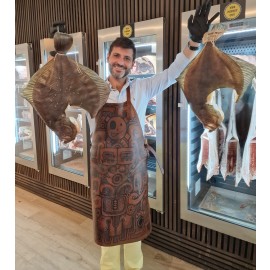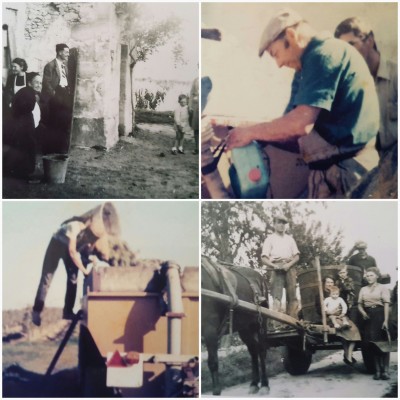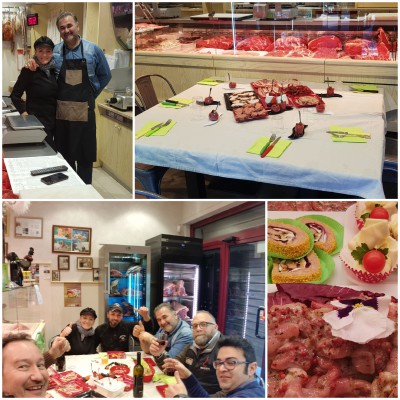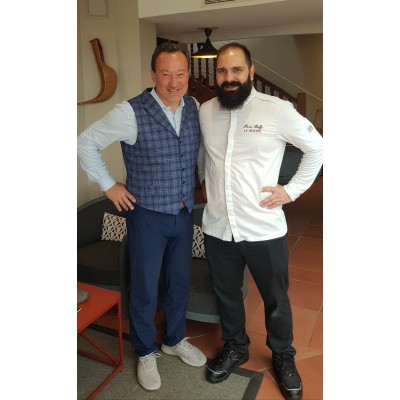Delightfully Fishy Dry-Aged Treasures

Enzo Sisto 15 september 2023

The Finest Cut's Journey into “Fishy Dry-Aged Delights”
Rui Gaudêncio fell in love with dry-aged meat during a trip to Portugal, and it led him to create "THE FINEST CUT".

"The Finest Cut". Leaving his marketing career, Rui self-taught himself in gastronomy for three years before opening his shop, as Rui recounts in an interview with Gault Millau, with Lucas Petrillo joining him in the kitchen.
We meet him at home to have a gourmet lunch, after visiting his "dry ageing lab" in Aubonne.
Dry aging, an age-old technique, is gaining popularity at The Finest Cut. They use it not only for meat but also for fish and eggs, hanging them in a maturation cellar with controlled temperature and humidity. This process can extend up to a year for red meat, allowing flavors to develop naturally.

The Tomahawk pork impresses with hazelnut notes and tenderness. Simmental beef pairs wonderfully with dry-aged egg yolk shavings. Line-caught red tuna and Scottish label rouge salmon maintain their pristine quality using Japanese sukibiki scaling. Esteemed chefs like Michel Roth and David Devel have embraced these delicacies on their menus.

Fish Dry Ageing: unveiling the Sukibiki Art.
In the world of culinary craftsmanship, precision and tradition often converge to create exceptional techniques, and one such art is Sukibiki. Imagine a meticulous dance where fish scales meet a sawing motion, a practice that demands care, skill, and practice to be executed flawlessly. This method of scaling fish is as gentle as a whisper on the fish's skin, and it holds a special place in the hearts of those who appreciate its finesse.
In today's culinary landscape, Sukibiki finds a contemporary twist as it plays a pivotal role in fish dry aging. It's not just about removing scales; it's also about peeling away the surrounding skin, a move that prevents moisture retention and the potential growth of unwanted bacteria during the dry aging process.

But, here's the intriguing part: Sukibiki is a technique selectively used in this context. It's a no-show when preparing fish for wet aging, as seen in the world of Edomae sushi, or when crafting the sublime delicacies of sushi and sashimi. It's a nod to the delicate balance between tradition and innovation, where age-old practices meet the demands of the modern culinary stage.
The Scientific Art of Dry-Aging Fish
In the realm of culinary science, dry-aging is not exclusive to beef; it extends its precision to the meticulous process of aging fish. This gastronomic pursuit hinges upon the creation and maintenance of a controlled environment where temperature and humidity levels are rigorously regulated, akin to its beef counterpart.

One pivotal distinction between aging beef and fish lies in their anatomical dissimilarity and the specific focus of the aging process. As elucidated by Chef Max Levy from Okra Bar during an interview at Michelin Guide, the latter involves comparatively smaller cuts and places a greater emphasis on the dynamics of evaporation.
The journey of dry-aging fish commences with its timely capture, followed by immediate dispatch to the restaurant. Here, the fish undergoes a well-defined sequence of preparatory steps. The method of choice for euthanasia is the ike jime, an ethically informed technique performed aboard the fishing vessel. Subsequently, the catch is skillfully disemboweled, scaled, and bathed in a mild saline solution.
The pivotal phase ensues as the meticulously prepared fish is enshrined in a breathable antimicrobial fabric, cocooned within a temperature-controlled box at a chilly 4-6°C. The duration of this confinement varies, contingent upon the fish's thickness. By the third day, a discernible transformation unfolds. The fish exhibits a denser and firmer texture, attributed to the loss of moisture. Simultaneously, enzymatic activity within the muscle cells catalyzes the degradation of the fish's proteins, fats, and glycogen—a carbohydrate—into their constituent amino acids, fatty acids, and sugars.

Of profound significance is the concomitant surge in glutamate levels, the fundamental compound responsible for imparting the coveted umami flavor profile. The process, however, does not unfold in isolation; vigilant daily inspection and cleansing of the fish are imperative to thwart the proliferation of undesirable microbial agents and enzymes.
Today, The Finest Cut is a part of the Affinitis group
'AFFINITIS GROUP" led by the passionate Albanian entrepreneur, Iris Saliu, who has made Swiss gastronomy of the highest quality his life's mission. One shining example of this commitment is Valais dried meat produced under the Michel Ebener (1964) label.
Valais dried meat has a rich heritage dating back to the 14th century. In recent decades, this artisanal craft has evolved into a highly professionalized industry, driven by its growing popularity. Across generations, recipes and expertise have been carefully passed down, preserving the exceptional quality and distinctive character of this product.
Michel Ebener crafts his dried meat using a secret recipe, a delicate blend of spices, and a sparing amount of salt, staying true to ancient traditions. After an intricate drying process spanning over 10 weeks, a genuine masterpiece of meat emerges.
The demanding climate of the Valais mountains made winter provisions a matter of survival. Consequently, shepherds and farmers began honing the art of salting and drying as early as the 14th century, harnessing the dry air, abundant sunshine, and persistent winds of the Rhône Valley.
Explore these culinary delights further at:
- [The Finest Cut] (https://thefinestcut.ch/)
- [Michel Ebener] (https://www.michelebener.ch/)
- [Affinitis Group] (https://affinitis.ch/en/)
Our visit to Switzerland, where we met Iris, Rui, and their circle of culinary enthusiasts, was an enlightening and delightful experience.
Rui has crafted something truly extraordinary for us – rolls made with 30-day dry-aged Australian Wagyu, adorned with a topping of wild sturgeon caviar:

or alternatively, with 90-day dry-aged Polish Heifer beef, generously filled with a mascarpone cheese infused with flavor:

The contrast in texture and taste is remarkable, offering hints of hazelnuts and cream in the first, and at times, notes of chocolate and moss in the second.
If you find yourself in Switzerland, don't hesitate to reach out to them, both professionally and personally. Thank you once again for the splendid hospitality.
Warm regards,
Enzo
Gerelateerde blogs

Chateau Arneau Boucher History
Enzo Sisto 8 januari 2017
Proud of his history Christophe show us some family's photo. Just enjoy the ambiance of the past!

National Butchers Italy
Enzo Sisto 3 maart 2019
Sermoneta February 2019 In the splendid setting of the Latin countryside a different and unusual lunch.

What's new in the Basque Country?
Enzo Sisto 30 juni 2022
The goal of coming to the Basque Country was first of all to have a look at the new trends in gastronomy and also to meet the local production of...